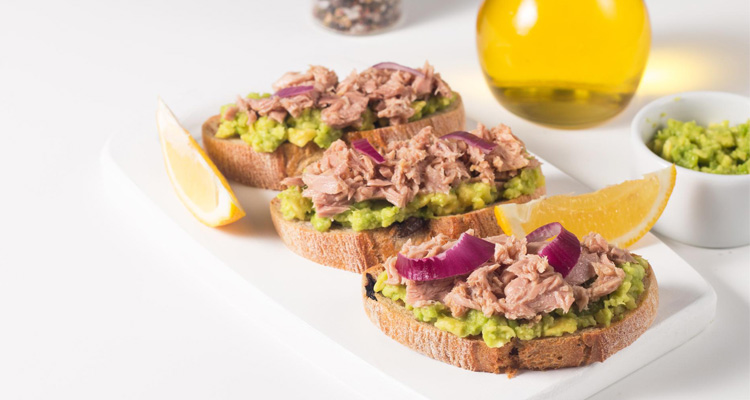Prepare your palate for a culinary adventure that celebrates the essence of freshness and flavor: Tuna Tartare. This elegant dish, originating from French cuisine, has become a global sensation. In this guide, we'll unravel the mysteries of Tuna Tartare, exploring its origins, the art of preparation, and answering your burning questions. Join us as we dive into the depths of the ocean to bring you a dish that harmonizes the richness of the sea with the vibrancy of fresh ingredients.
Nutrition Facts
- Kcal
280 - Fat
14 g - Choles
45 mg - Sodium
400 mg - Carbs
12 g - Fiber
5 g - Sugar
2 g - Protein
30 g
Note: The nutrition facts are approximate values and may vary based on the specific ingredients used and any additional toppings or syrups added.
Ingredients
- 1 lb (450g) sushi-grade tuna, diced into small cubes
- 2 tablespoons soy sauce
- 1 tablespoon sesame oil
- 1 tablespoon freshly squeezed lime juice
- 1 teaspoon honey or agave syrup
- 2 green onions, finely chopped
- 1 avocado, diced
- 1 teaspoon black sesame seeds, for garnish
- 1 teaspoon chopped fresh cilantro, for garnish
- 1 teaspoon sliced radishes, for garnish
- 1 teaspoon microgreens, for garnish
- 1 teaspoon Sriracha sauce, for spice (optional)
- Wonton crisps or crackers, for serving
Directions
- Prepare the Dressing: In a small bowl, whisk together soy sauce, sesame oil, lime juice, and honey. Adjust the seasoning to taste. If you prefer a bit of spice, add Sriracha sauce according to your preference.
- Combine Tuna and Vegetables: In a medium mixing bowl, gently combine the diced tuna, green onions, and avocado. Be careful not to mash the avocado; you want to keep distinct pieces.
- Add Dressing: Pour the prepared dressing over the tuna mixture. Toss gently to coat the ingredients evenly with the dressing.
- Plate the Tartare: Divide the tuna tartare mixture into individual serving bowls or plates. Create a mound in the center of each plate.
- Garnish: Sprinkle black sesame seeds, chopped cilantro, sliced radishes, and microgreens over the tuna tartare for a pop of color, texture, and flavor.
- Serve: Serve the tuna tartare immediately with wonton crisps or crackers on the side for scooping and crunch.
Exploring the Origins of Tuna Tartare
A Glimpse into Culinary History
Tuna Tartare emerged as a culinary innovation in upscale French restaurants, offering diners a delightful contrast to cooked seafood. Its popularity soared due to its raw, fresh nature, showcasing the pure essence of high-quality tuna.
The Significance of Freshness
At the heart of Tuna Tartare lies the essence of freshness. Chefs meticulously select the finest sushi-grade tuna, ensuring its quality and safety for raw consumption. The dish's allure lies in the raw tuna's delicate texture and the burst of flavors from carefully chosen accompaniments.
The Art of Crafting Tuna Tartare: A Gastronomic Symphony
Choosing the Right Tuna
The foundation of exceptional Tuna Tartare is the tuna itself. Sushi-grade Ahi tuna is preferred, characterized by its deep red color and buttery texture. This premium choice guarantees a melt-in-your-mouth experience.
Mastering the Cut
The key to a perfect Tuna Tartare lies in the precision of the cut. Chefs expertly dice the tuna into small, uniform cubes, ensuring every bite offers a harmonious blend of flavors and textures. The finesse in cutting enhances the dish's visual appeal, making it as aesthetically pleasing as it is delicious.
Seasoning to Perfection
Tuna Tartare is elevated with a medley of seasonings. A combination of soy sauce, sesame oil, freshly squeezed lime juice, and a hint of wasabi creates a tantalizing marinade. Additional ingredients like chopped chives, avocado, and cucumber add layers of taste, texture, and color, enhancing the overall dining experience.
FAQs
Is Tuna Tartare Safe to Eat?
Yes, when prepared with fresh, high-quality tuna labeled as sushi-grade, Tuna Tartare is safe to eat raw. It's crucial to source the tuna from reputable suppliers.
Can I Substitute Tuna with Another Fish?
While traditionally made with tuna, Tuna Tartare can be prepared with other sushi-grade fish like salmon or yellowtail. The key is to ensure the fish is safe for raw consumption.
How Do I Store Leftover Tuna Tartare?
Leftover Tuna Tartare should be consumed immediately to maintain its freshness. Avoid storing it for prolonged periods as raw fish does not keep well.
Can I Customize the Seasonings?
Absolutely! Tuna Tartare is highly customizable. Feel free to adjust the seasonings and accompaniments according to your taste preferences. Experimentation can lead to unique and delightful variations.
What Are the Best Accompaniments for Tuna Tartare?
Classic accompaniments include crispy wonton chips, toasted baguette slices, or fresh lettuce leaves for wrapping. These add a delightful crunch and complement the creamy texture of the tartare.
Is Tuna Tartare Gluten-Free?
Yes, Tuna Tartare is inherently gluten-free. However, it's essential to check the labels of sauces and condiments to ensure they do not contain gluten.
Conclusion
Tuna Tartare, with its symphony of fresh flavors and luxurious textures, is a culinary masterpiece that promises a gourmet experience like no other. Whether you're indulging in its exquisite taste at a fine dining restaurant or mastering the art of preparation in your own kitchen, Tuna Tartare is a testament to the culinary delights the ocean has to offer. So, venture into the world of raw seafood, embrace the freshness, and let the tantalizing taste of Tuna Tartare awaken your senses.













